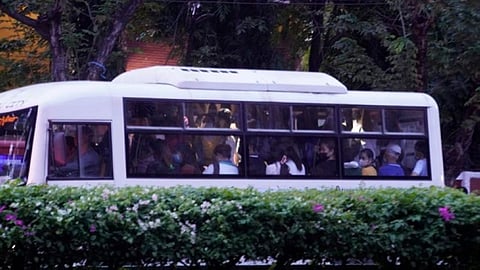

TRAFFIC officials in the cities of Cebu, Lapu-Lapu, Mandaue and Talisay admitted to allowing standing passengers inside public utility vehicles (PUV) even before the memorandum circular of the Land Transportation Franchising and Regulatory Board (LTFRB) allowing this came out on Monday, Sept. 26, 2022.
Under Memorandum Circular 2022-070, the LTFRB on Monday allowed PUVs in areas under the least restrictive Alert Level 1 to accommodate standing passengers.
Local traffic officials said they allowed overloading in PUVs during peak hours due to several factors, including the high demand for public transportation and as a way to mitigate bumper-to-bumper traffic in their respective jurisdictions.
Cebu City Transportation Office executive director Paul Gotiong told SunStar Cebu on Wednesday, Sept. 28, that they decided to allow PUVs to allow standing passengers after noticing the long queues of commuters waiting for a ride to and from home during peak hours.
Gotiong added that by allowing passengers to stand inside PUVs, the demand for public transport during peak hours will be mitigated.
But Gotiong said this measure is still not sufficient to cater to all commuters during peak hours since there is a high demand for more public transportation.
In order to address the deficiency, Gotiong urged PUV operators to manage their units by deploying them in routes where there is a high volume of commuters.
According to the LTFRB Central Visayas’ latest data, there are a total of 439 modern public utility jeepneys (PUJs) and close to 2,000 traditional PUJs plying the routes of Cebu City.
Cebu City’s transport situation was also felt in Lapu-Lapu City.
Mario Napuli, head of the Lapu-Lapu City Traffic Management System, told SunStar Cebu that the lack of PUVs plying the streets was also the reason they allowed PUVs to accommodate standing passengers.
Napuli admitted that they started allowing PUVs to accommodate standing passengers as early as April this year or when the city was placed under the less restrictive Alert Level 1 status.
“What we are seeing is that we lack PUVs to cater to so many commuters. Even our modernized jeeps are not enough. That is why we are often seeing so many commuters still waiting on the streets for a ride home,” Napuli said in Cebuano.
Earlier, Lapu-Lapu City Mayor Junard “Ahong” Chan was quoted as saying he had not approved the applications of PUV operators in the city as they were still looking for ways to solve their current traffic problem.
Officials of Lapu-Lapu City’s next door neighbor, Mandaue, said that while they allowed overloading in their PUVs, they allowed this only during peak hours.
Edwin Anthony Jumao-as, executive director of the Traffic Enforcement Agency of Mandaue, said they allow PUVs to accommodate standing passengers only from 6 to 8 a.m. and 5 to 7 p.m.
Traffic management
In the case of Talisay City in southern Cebu, traffic officials there allowed the overloading of PUVs as a way to immediately address traffic in their busy streets.
Jonathan Tumulak, head of the City of Talisay Traffic Operation and Development Authority, told SunStar Cebu on Wednesday that they had allowed PUVs to accommodate standing passengers since the start of in-person classes in all public and private schools last August.
Tumulak said he had tolerated the practice as his priority was to manage the city’s traffic situation, which had worsened since the city was placed under Alert Level 1 earlier this year.
Tumulak said modern jeepneys that ply city roads from Barangay Poblacion in Talisay City to Cebu IT Park in Cebu City are sometimes overloaded, but usually during rush hour.
He added that they can minimize overloading as long as there are enough PUVs operating in the city. (IRT, MKG, BBT / PJB)